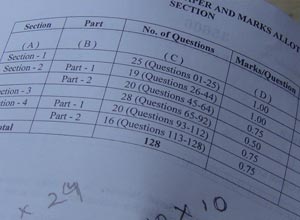MAH CET 2014 paper analysis: New questions added
By Tarun Malik
Directorate of Technical Education, Maharashtra conducted its Common Entrance Test for admission to MBA/MMS and PGDBM/PGDM courses offered in various institutes in Maharashtra. The test is being conducted in two time slots (10:15 am-12:45 pm and 2:15 pm-4:45 pm) and will span over a two day window i.e. March 15-16.
The computer based test comprises 200 questions from three broad sections (Quantitative Aptitude, Verbal Ability and Reading Comprehension, and Logical/Abstract Reasoning) and a student needs to attempt them in 150 minutes. There is no demarcation among questions from different sections; one can easily find an RC passage sandwiched between a set on Data Interpretation and Syllogisms. The fact that the test has no negative marking provides much needed respite to the candidates. Given the number of questions, MH-CET is clearly a test of your speed and accuracy. The exam is largely on the lines of previous CETs; though a few new questions types have also been reported.
Given below is a general overview of the exam:
| Area |
Number of questions |
Difficulty level |
| Quantitative Aptitude |
50 |
Easy-Moderate |
| Logical Reasoning |
90 |
Moderate |
| Verbal Ability and Reading Comprehension |
60 |
Moderate |
| Total |
200 |
Moderate |
Quantitative Aptitude
Of around 50 questions in QA, 20 questions have been reported to be from areas such as Arithmetic and Geometry (including a couple of questions each from Probability and Algebra). The questions varied from easy to moderate in terms of difficulty. Data Interpretation formed a major chunk of this area with four sets of five questions each. Five questions each from Data Sufficiency and comparison of quantities have also been reported. This set of 50 questions was fairly easy and an attempt of about 40 questions here can be said to be a good attempt.
Logical/Abstract Reasoning
With a total of 90 questions, this section constitutes a little less than half of the entire paper. Right question selection in this area is critical as about 20-25 questions have been reported to be quite time consuming. The 30 odd questions from Visual Reasoning, some of which have been reported to be quite difficult and time consuming, can prove to be a problem area if the students do not have enough practice in the same. Four sets of seven questions each have been reported on Arrangements, of which two sets were more difficult than the others and could have been avoided to save time. The five questions on Series have also been reported to be slightly difficult. The remaining questions on Input/Output, Blood Relations, Coding/Decoding, Data Sufficiency, and Syllogisms have been reported to range from easy to moderate in terms of level of difficulty.
Verbal Ability and Reading Comprehension
If one were to ignore the 10 questions on Reading Comprehension (two passages with five questions each), this section could easily be dubbed as the easiest of the three. The passages have been reported to be abstract in nature followed by a few inference based questions. Nevertheless, the remaining 50 questions from this area have been reported to be fairly easy. Spelling/Inappropriate usage, phrase replacement, Para Jumbles (six sentence type), Odd Sentence Para Jumble (a la CAT, though this has five sentences unlike CAT, which has four) and Synonym/Antonym, all have been reported to have five questions each. Two cloze passages with five blanks each also featured and have been reported to be fairly easy. A new question type based on “Probable starters” could have confused many as the directions provided were not very clear. There are five of these, all of which are reported to be easy. Critical Reasoning comprises the remaining 10 questions which are easy to moderate in level of difficulty. An attempt of about 45 questions from this area can be considered to be quite good.
Quantitative Aptitude, Data Interpretation and Verbal Ability are the areas where the students can look to maximise their attempts. Questions on Visual Reasoning, Series, Input/Output and Arrangements, on the other hand, can prove to be a bit troublesome. Overall, a genuine attempt of about 150 can be considered good. However, a score less than 140 is unlikely to fetch a call from JBIMS.
About the author
Tarun Malik is the Product Head - MBA at Career Launcher.
Disclaimer: All information is based on independent analysis and evaluation made by Career Launcher. We do not take responsibility for any decision that might be taken, based on this information. We do not encourage or indulge in discussion and dissemination of exam questions in any form.

